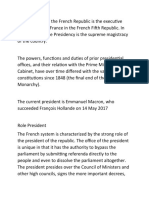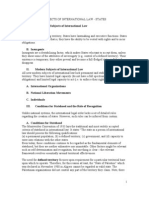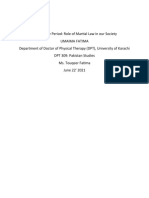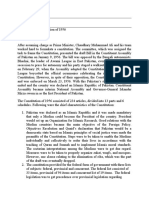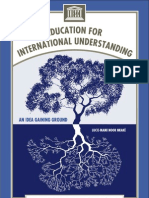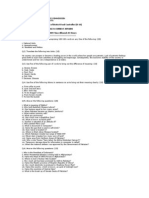The United Nations: Aims, Organs and Other Details
The United Nations: Aims, Organs and Other Details
Uploaded by
Anonymous z9E7vhQ3TjCopyright:
Available Formats
The United Nations: Aims, Organs and Other Details
The United Nations: Aims, Organs and Other Details
Uploaded by
Anonymous z9E7vhQ3TjOriginal Description:
Original Title
Copyright
Available Formats
Share this document
Did you find this document useful?
Is this content inappropriate?
Copyright:
Available Formats
The United Nations: Aims, Organs and Other Details
The United Nations: Aims, Organs and Other Details
Uploaded by
Anonymous z9E7vhQ3TjCopyright:
Available Formats
The United Nations: Aims, Organs and Other
Details
The United Nations: Aims, Organs of the United Nations and
Other Details!
The world witnessed two devastating wars in the 20th century. The First World War
broke out in 1914 and continued till 1918. Millions of people were killed, wounded,
maimed, crippled and rendered homeless.
The horror and tragedy of the First World War led to a universal desire for peace.
It was felt that some international organization should be created to prevent future
wars. Out of this desire was born the League of Nations. The primary aim of the League
of Nations was to preserve peace and promote international cooperation.
The League of Nations failed to maintain peace and the Second World War broke out in
1939. The outbreak of the Second World War revealed to the world the weaknesses of
the League of Nations. It was felt that a much stronger international organisation should
be created, if the world was to have peace. The Second World War which broke out in
1939 came to an end in 1945.
The Atlantic charter:
Even before the end of the war, in August 1941, the U.S. President, Franklin Roosevelt,
and the British Prime Minister, Winston Churchill, met on a battleship, the Cruiser, in
the mid-Altantic and drew up the Atlantic Charter which was released on 14 August,
1941.
The Charter had the following objectives:
(1) To maintain international peace and security;
(2) To encourage international cooperation in the spheres of social, economic and
cultural developments;
(3) To develop friendly relations among nations on principles of equal rights and selfdetermination;
(4) To recognise the fundamental rights of all people.
United Nations declaration or the Washington declaration:
On 1 January, 1942, representatives of 26 Allied countries met in Washington and
signed a Declaration of United Nations. The signatories endorsed the principles of the
Atlantic Charter. This was the first time that the term United Nations was used.
The UN Charter finally emerged after three major conferencesthe Dumbarton Oaks
Conference (1944), the Yalta Conference (1945) and the San Francisco Conference
(1945). At the Dumbarton Oaks Conference the representatives of four major powers
(Britain, the United States, the Soviet Union and China) agreed on proposals for the
aims, structure and functioning of the United Nations. They voted for an Assembly, a
Security Council, a Secretariat and an International Court. The Yalta Conference
decided on the voting procedure to be followed by the Security Council.
Membership of the United Nations was to be opened to all peace- loving states.
Representatives of fifty nations met at San Francisco to sign the Atlantic Charter. Poland
signed it later and became one of the original 51 member states.
The United Nations officially came into existence on 24 October, 1945. The Charter had
been ratified by the five big powers Britain, China, France, the Soviet Union, and the
United States and by a majority of the other signatories.
The 24th of October is celebrated as United Nations Day. Today, the organization has
192 members.
The headquarters of the United Nations is located in New York, USA. The organization
has six official languages- English, French, Spanish, Russian, Chinese and Arabic. Its
flag bears its emblem, a map of the world encircled by two bent olive branches.
Aims of the United Nations:
The objectives of the United Nations, according to its Charter,
are:
(1) To maintain international peace and security.
(2) To develop friendly relations among nations on the basis of equality and the
principle of self-determination.
(3) To foster worldwide cooperation in solving economic, social, cultural and
humanitarian problems.
(4) To promote human rights and fundamental freedom for the people of the world.
(5) To serve as a centre where various nations can coordinate their activities towards the
attainment of the objectives of the United Nations.
(6) To save succeeding generations from the scourge of war.
The organs of the United Nations:
The UN has six principal organs to carry out its functions:
1. The General Assembly,
2. The Security Council,
3. The Economic and Social Council,
4. The Trusteeship Council,
5. The International Court of Justice and
6. The Secretariat.
The General Assembly:
The General Assembly is the largest organ of the UN. All members of the UN are
members of the General Assembly. Each state can send up to five representatives but is
entitled to one vote in the Assembly. This ensures that all the member states have equal
status.
The General Assembly meets once a year for three months. But special sessions may be
held during times of crisis. At the beginning of every session, the Assembly elects a new
President.
The functions of the General Assembly are as follows:
1. It can discuss any matter affecting international peace and security.
2. It makes recommendations for peaceful settlements of disputes.
3. It passes the budget of the UN.
4. It elects the non-permanent members of the Security Council.
5. It also elects the members of the Economic and Social Council and the Trusteeship
Council.
6. It admits new members to the UN on the recommendation of the Security Council.
7. The Security Council and the General Assembly elect the members of the
International Court of Justice.
8. In recent years the General Assembly has increased its power through a resolution
called Uniting for Peace Resolution. The General Assembly can make recommendations
for collective measures, including the use of armed forces, in case the Security Council
is unable to take a decision during a crisis.
Decisions are taken in the General Assembly by a simple majority vote. In some
important cases a two-thirds majority vote is required for taking a decision.
The Security Council:
The Security Council is the most important and effective organ of the UN. It is the
executive wing of the UN. The Security Council consists of 15 members. Five of them are
permanent members, namely Britain, China, France, Russia and the USA. The ten nonpermanent members are elected by the General Assembly for a term of two years.
Each member has one vote. Decisions are taken by a majority vote of at least nine
members including the five permanent members. Each permanent member has the
power to reject or veto a decision. This means a negative vote by any one of the
permanent members would lead to a cancellation of the resolution. The Council is
powerless to act if there is such a veto by any permanent member although it may be
supported by all other permanent members.
The Security Council has the basic responsibility of maintaining peace and security in
the world. The Security Council meets once a month but in the event of an emergency, a
meeting may be held whenever required.
Functions of the Security Council:
1. To maintain international peace and security in the world.
2. Toinvestigate international disputes and recommend appropriate methods of
settling them.
3. To call on member states to apply economic sanctions against the aggressor and thus
to put pressure on the guilty state to stop aggression.
4. The Security Council may take military action against the aggressor, if required.
The International Court of Justice:
The International Court of Justice, located in The Hague, Netherlands, is the principal
judicial organ of the United Nations.
The Court consists of 15 Judges from different countries elected by the General
Assembly and the Security Council. They are elected for a nine-year term. No two judges
can be citizens of the same country.
Functions of the International Court of Justice:
(1) To settle disputes brought to it by member nations.
(2) To provide legal advice to any organ of the UN on request.
The Trusteeship Council:
The Trusteeship Council was set up immediately after the Second World War. It was set
up to ensure the proper administration and development of those areas of the world that
were under foreign rule. The Council was also to take steps to help them attain selfgovernment. By 1994, all Trust Territories had attained self-government. The Council
will now meet only if required to do so.
The Economic and Social Council:
The Economic and Social Council consists of 54 members elected by the General
Assembly for a three-year term.
The ECOSOC discusses major economic and social issues. It is mainly concerned with
the management of the UNs social, economic, cultural and humanitarian activities.
Its main functions are as follows:
1. To promote economic and social progress.
2. To solve problems relating to health, illiteracy,unemployment , etc.
3. To coordinate the functions of the agencies of the UN like the International Monetary
Fund (IMF), the International Labour Organization (ILO), the Food and Agricultural
Organization (FAO), the World Health Organization (WHO), the United Nations
Educational Scientific and Cultural Organization (UNESCO), the United Nations
International Childrens Fund (UNICEF), etc.
The Secretariat:
The Secretariat is the principal administrative department of the UN. It is headed by the
Secretary-General appointed by the General Assembly on the recommendation of the
Security Council for a term of five years. He can be re-elected.
The staff of the Secretariat is appointed by the Secretary-General. They are chosen from
among the 192 member countries. The Secretary- General holds a key position in the
administration of the affairs of the UN. He organises conferences, oversees peacekeeping operations, drafts reports on economic and social trends, prepares studies on
human rights, mediates in international disputes and prepares budget estimates.
It is to be noted that the United Nations can achieve success only if the member states
cooperate with it. All member countries must abide by the policies and programmes of
the United Nations, if the latter is to succeed as a peace-keeping organisation.
You might also like
- Ucsp Tos and Test Question 2nd QuarterDocument6 pagesUcsp Tos and Test Question 2nd QuarterApel LaboneteNo ratings yet
- Theconstitution Pakistan Muslim League - NDocument30 pagesTheconstitution Pakistan Muslim League - NAhmad AzharNo ratings yet
- United Nations History & WikipediaDocument24 pagesUnited Nations History & WikipediaAamir HussainNo ratings yet
- United NationsDocument20 pagesUnited NationsVikas ChoudharyNo ratings yet
- Government of India Act 1935Document5 pagesGovernment of India Act 1935Muhammad Asad Faroqui100% (1)
- France ParlamentDocument4 pagesFrance ParlamentAndi AlbaniaNo ratings yet
- 30 Questions On The Journey To The Constitution of PakistanDocument6 pages30 Questions On The Journey To The Constitution of Pakistanapi-26473353067% (3)
- AsylumDocument3 pagesAsylumSujan Ganesh100% (1)
- United Nations OrganisationDocument4 pagesUnited Nations OrganisationSanjay SaptarshiNo ratings yet
- Zulfiqar Ali BhuttoDocument18 pagesZulfiqar Ali BhuttohassanNo ratings yet
- Countdown To PartitionDocument44 pagesCountdown To PartitionMuqadsa ZainebNo ratings yet
- Constitutional History of Pakistan. Compiled By: Ali Haider. 1. PrefaceDocument27 pagesConstitutional History of Pakistan. Compiled By: Ali Haider. 1. Prefaceathar riaz100% (1)
- Political History of PakistanDocument32 pagesPolitical History of PakistanMargoob AhmadNo ratings yet
- Ordinance Making Power of Indian ExecutiveDocument3 pagesOrdinance Making Power of Indian ExecutiveAryan DasNo ratings yet
- Judicial ReviewDocument5 pagesJudicial ReviewSabyasachi Ghosh100% (1)
- Court System in PakistanDocument14 pagesCourt System in Pakistanharismasood900% (1)
- Indian Independence Act 1947Document3 pagesIndian Independence Act 1947Hammad AliNo ratings yet
- Salient Features of 1962 ConstitutionDocument3 pagesSalient Features of 1962 ConstitutionMúhámmáD Táríqúé RáhóóJóNo ratings yet
- Government of India Act 1935 Converted 1Document13 pagesGovernment of India Act 1935 Converted 1Muhammad AwaisNo ratings yet
- Acts From 1858Document20 pagesActs From 1858sharanyarashmir5No ratings yet
- Constitution of Pakistan: Relations Between Federation and ProvincesDocument11 pagesConstitution of Pakistan: Relations Between Federation and ProvincesSuhrab Khan JamaliNo ratings yet
- Subjects of International Law - StatesDocument4 pagesSubjects of International Law - Stateskaus222No ratings yet
- Constitution 1956 FinalDocument19 pagesConstitution 1956 Finalmuhammad qureshi100% (1)
- Simon Commission Notes PDFDocument7 pagesSimon Commission Notes PDFHamnaNo ratings yet
- Kaniz Fatima CaseDocument3 pagesKaniz Fatima CaseSamerNo ratings yet
- Martial LawDocument14 pagesMartial LawBint e ArshadNo ratings yet
- France: Political System: I. Form of GovernmentDocument6 pagesFrance: Political System: I. Form of GovernmentDaphnie CuasayNo ratings yet
- Scope of International LawDocument6 pagesScope of International LawSURIYA KANNANNo ratings yet
- Assignment On EquityDocument18 pagesAssignment On EquityTAJ AHAMEDNo ratings yet
- Salient Features LFO 2002Document6 pagesSalient Features LFO 2002Eman IshaqNo ratings yet
- Constitutional and Administrative Reforms in NWFP: Bray CommitteeDocument2 pagesConstitutional and Administrative Reforms in NWFP: Bray CommitteeWaqas AzizNo ratings yet
- Important International OrganizationsDocument4 pagesImportant International Organizationsuma100% (1)
- Jinnah Ghandi Talks 1944Document5 pagesJinnah Ghandi Talks 1944Moin SattiNo ratings yet
- The General Assembly of The UNDocument13 pagesThe General Assembly of The UNDebojeet MukherjeeNo ratings yet
- Functions of Un General AssemblyDocument24 pagesFunctions of Un General AssemblyRitesh kumar100% (1)
- Comparison Between Jinnah and GandhiDocument18 pagesComparison Between Jinnah and Gandhimadnan27No ratings yet
- Composition and Role of The SENATE in Pakistan.Document6 pagesComposition and Role of The SENATE in Pakistan.Muhammad Sohail Irshad100% (1)
- Constitutional History of PakistanDocument4 pagesConstitutional History of PakistanSaad KhanNo ratings yet
- A Comparative Analysis of The Right of PremptionDocument9 pagesA Comparative Analysis of The Right of PremptionGroup Of Cheaters (ফাতরা)No ratings yet
- Relationship Between Law and PoliticsDocument2 pagesRelationship Between Law and Politicsmohd shueabNo ratings yet
- Quaid AZAMDocument7 pagesQuaid AZAMmohammad_mohd_30% (1)
- Minto-Morley Reforms of 1909Document2 pagesMinto-Morley Reforms of 1909Sachika VijNo ratings yet
- Morley MintoreformsDocument3 pagesMorley MintoreformsHardeep SinghNo ratings yet
- Independence Act 1947Document23 pagesIndependence Act 1947Muqadsa Zaineb100% (1)
- Chapter 11 Congress NotesDocument7 pagesChapter 11 Congress NotesChristian AndersonNo ratings yet
- Constitution of 1956.1962Document4 pagesConstitution of 1956.1962Muhammad Mustafa RazaNo ratings yet
- Article 199 High CourtDocument4 pagesArticle 199 High CourtFakhar Haider100% (1)
- The Government of India Act 1935Document5 pagesThe Government of India Act 1935syed babar khan babar khanNo ratings yet
- The Independence ActDocument6 pagesThe Independence ActAkhilDixit100% (1)
- Sources of International LawDocument6 pagesSources of International LawMona Lisa Uli ManullangNo ratings yet
- Magna CartaDocument2 pagesMagna CartaRenz Austero BanzagalesNo ratings yet
- Salient Feature of Govt of India Act 1935 and Short ComingsDocument5 pagesSalient Feature of Govt of India Act 1935 and Short ComingsIrtaza HassanNo ratings yet
- Writ PetitionsDocument4 pagesWrit PetitionsMAmoon Rasheed BachaNo ratings yet
- Fundamental Rights Constitution of Pakistan 1973Document4 pagesFundamental Rights Constitution of Pakistan 1973Alee HaiderNo ratings yet
- Punjab Land Revenue Rules, 1968 PDFDocument112 pagesPunjab Land Revenue Rules, 1968 PDFMuhammadTahirRiazNaqeebi71% (7)
- Crash Course U.S. Government and Politics 40 Political PartiesDocument2 pagesCrash Course U.S. Government and Politics 40 Political PartiesAisha AwwadNo ratings yet
- Salient Features of Indian ConstitutionDocument9 pagesSalient Features of Indian ConstitutionChandralekha K RemaNo ratings yet
- UNO - Objectives, Composition and RoleDocument6 pagesUNO - Objectives, Composition and RolePrasanta BhowmikNo ratings yet
- The United Nations: First World WarDocument6 pagesThe United Nations: First World Warsreedevi sureshNo ratings yet
- An Exclusive Project Report On United Nations OrganizationDocument15 pagesAn Exclusive Project Report On United Nations OrganizationDilip JaniNo ratings yet
- International OrganizatonDocument42 pagesInternational OrganizatonSanjay TimalsinaNo ratings yet
- Dag Hammarskjöld and Global GovernanceDocument49 pagesDag Hammarskjöld and Global GovernanceDag Hammarskjöld FoundationNo ratings yet
- Sikh Humn Right GroupDocument7 pagesSikh Humn Right Groupshrg ngoNo ratings yet
- Education For International UnderstandingDocument48 pagesEducation For International UnderstandingPaRaDoX eLaKSaMaNa100% (1)
- Handbook PresentationDocument17 pagesHandbook Presentationanon_801054085No ratings yet
- Diss2 Humss9 March31activity Mandani PDFDocument5 pagesDiss2 Humss9 March31activity Mandani PDFCLARENCE ALDRICH MANDANINo ratings yet
- Format of Draft ResolutionDocument4 pagesFormat of Draft ResolutionRiya 2418No ratings yet
- IMUN Online Conference 83.0: Experience The Best of Diplomacy and ExcellenceDocument3 pagesIMUN Online Conference 83.0: Experience The Best of Diplomacy and ExcellenceAndika SaputranstNo ratings yet
- Thesis Topics On Human RightsDocument7 pagesThesis Topics On Human RightsKelly Taylor100% (2)
- Chapter One: General Introduction: Definitions of International LawDocument52 pagesChapter One: General Introduction: Definitions of International LawYugichha SangroulaNo ratings yet
- Convention On The Prevention and The Punishment of The Crime of GenocideDocument8 pagesConvention On The Prevention and The Punishment of The Crime of GenocideMuhammad IbrahimNo ratings yet
- New Global Ethic Challenges For The ChurchDocument10 pagesNew Global Ethic Challenges For The ChurchzeleniplanetNo ratings yet
- Evaluation of The UN-Habitat Urban Programme in IraqDocument94 pagesEvaluation of The UN-Habitat Urban Programme in IraqUnited Nations Human Settlements Programme (UN-HABITAT)No ratings yet
- For Commission ExamDocument46 pagesFor Commission Examidreewaris1988No ratings yet
- Rau's Focus June2020 PDFDocument160 pagesRau's Focus June2020 PDFsarawalem1No ratings yet
- Mission StartUp Field Guide 1aug2010 PDFDocument219 pagesMission StartUp Field Guide 1aug2010 PDFDaniel FernandesNo ratings yet
- Liberty Quotations - 2 PDFDocument108 pagesLiberty Quotations - 2 PDFWagz KagiriNo ratings yet
- Routledge Handbook of International Organization (Bob Reinalda)Document11 pagesRoutledge Handbook of International Organization (Bob Reinalda)Scintilla SelenophileNo ratings yet
- LDC ListDocument1 pageLDC ListNithish RRNo ratings yet
- Ethnic Warfare in Sri Lanka and The U.N. Crisis (William Clarance)Document325 pagesEthnic Warfare in Sri Lanka and The U.N. Crisis (William Clarance)Nanni ThanimaramNo ratings yet
- g12 Topical English 2001 - 2016Document152 pagesg12 Topical English 2001 - 2016Zunga MwaangaNo ratings yet
- Rupert Emerson ColonialismDocument15 pagesRupert Emerson ColonialismTithi BhattacharyaNo ratings yet
- THE CONTEMPORARY WORLD Reviewer Midterms - VTNGCLDocument3 pagesTHE CONTEMPORARY WORLD Reviewer Midterms - VTNGCLjoker ramosNo ratings yet
- 2013 State of Civil Society ReportDocument303 pages2013 State of Civil Society ReportPatrick GatharaNo ratings yet
- The UN System and Cities in Global Governance: Chadwick F. AlgerDocument169 pagesThe UN System and Cities in Global Governance: Chadwick F. AlgerCatarina BezerraNo ratings yet
- UN Rapporteur Kaye Asked Guterres USG Smale About Ousting Inner City Press Answer Full of Lies Still BannedDocument2 pagesUN Rapporteur Kaye Asked Guterres USG Smale About Ousting Inner City Press Answer Full of Lies Still BannedMatthew Russell LeeNo ratings yet
- United NationsDocument20 pagesUnited Nationslevibro guy0% (1)
- RGSMUN III - Delegate GuideDocument8 pagesRGSMUN III - Delegate Guidenunya78No ratings yet
- Chapter 6 International OrganisationsDocument73 pagesChapter 6 International OrganisationsMalavika BNo ratings yet
- 48th National DayDocument67 pages48th National DayraguNo ratings yet





